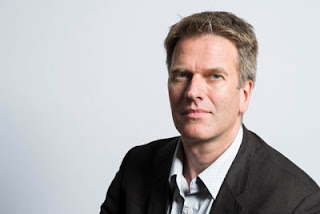 |
| Charles Fernyhough, photo by Ben Gilbert/Wellcome Images |
Charles Fernyhough is the author of the new book The Voices Within: The History and Science of How We Talk to Ourselves. His other books include A Box of Birds and Pieces of Light. A psychologist, he directs the Hearing the Voice project at Durham University. He lives in County Durham, U.K.
Q: In The Voices Within, you write, “Talking to ourselves is a part
of human experience that, although by no means universal, seems to play many
different roles in our mental lives.” What are some of the roles it plays?
A: We talk to ourselves for all sorts of reasons. When we do
it out loud, it’s called private speech; the silent, internal version is called
inner speech.
Both versions seem to have a range of different functions.
We talk to ourselves to plan what we are about to do, such as when we
anticipate a difficult meeting. We use inner speech to motivate ourselves,
perhaps to psych ourselves up for a tennis match or scary interview.
We can also use language to tell ourselves off and talk
through how we’ll do better next time. Inner speech features in remembering,
imagination, creativity, and daydreaming, and in preparing for what we are
about to say out loud - particularly if we are speaking an unfamiliar
language.
Q: You note that talking to yourself has a social role. Can
you say more about that?
A: In one sense, inner speech is the opposite of social - it
is language addressed to the self. But it seems to have a lot in common with
the language we use to communicate with other people.
The most prominent theory about inner speech, that of the
Russian psychologist Lev Vygotsky, says that inner speech begins as social
dialogue and gradually becomes internalised. That is, words that were
previously used to influence the behavior of others become turned back onto the
self.
We can see this change happening in childhood, as children
move from social conversations, through a stage of private speech (talking to
themselves out loud), and ultimately to silent self-talk (inner speech).
One important implication of this is that even ‘solitary’
inner speech has a social structure - we really are talking *to*
ourselves.
Q: In the book, you discuss the voices someone hears while
reading a book. What goes on in a reader’s head and what are they likely to be
hearing?
A: I remember being asked as a child whether, when I read a
book, I could hear the characters speaking in my head. I said that I could (and
my own young son recently said the same).
In The Voices Within, I describe a survey we conducted
with a large sample of keen readers. Around 1 in 7 said they could hear the
characters in a novel speaking as clearly as if a person had been in the same
room as them, speaking aloud. We hope to publish the full results of this study
next year.
Q: You ask, “What do you think when you think of someone who
hears voices?” What are some of the responses to this question, and what are
some of the perceptions and misperceptions about “hearing voices”?
A: Hearing voices is horribly stigmatised. A recent survey
of U.S. media outlets found that, in around half of the cases in which hearing
voices was mentioned, the article made a connection to violence.
This is a gross misrepresentation of an experience that is
part of everyday life for a large number of people. Hearing voices is
associated with a range of mental disorders, including but not limited to
schizophrenia, but it is also experienced regularly by a significant number of
people who are not mentally ill. Our best guess is that a further 5 to 15
percent of regular people will have some occasional or fleeting voice-hearing
experience.
The key thing to bear in mind is that many people have had
this experience, and many are living comfortably with it. There is support and
information out there.
Q: What are you working on now?
A: I am currently working on a novel about faith and
science, set in the Middle Ages.
--Interview with Deborah Kalb



No comments:
Post a Comment